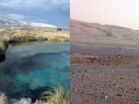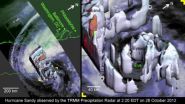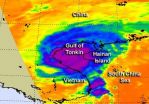(Press-News.org) Millions of years ago fire and water forged the gypsum rocks locked in at Cuatro Ciénegas, a Mexican valley similar to the Martian crater where NASA's Rover Curiosity roams. A team of researchers have now analysed the bacterial communities that have survived in these inhospitable springs since the beginning of life on Earth.
"Cuatro Ciénegas is extraordinarily similar to Mars. As well as the Gale crater where Curiosity is currently located on its exploration of the red planet, this landscape is the home to gypsum formed by fire beneath the seabed," as explained to SINC by Valeria Souza, evolutionary ecologist at the National Autonomous University of Mexico (UNAM).
The researcher states that sulphur components from magma and minerals from the sea (carbonates and molecules with magnesium) are required to form gypsum. In the case of the Cuatro Ciénegas Basin, the magma under the seabed was very active. In fact, it allowed for the continent displacement during the Jurassic Period: "Here was where the supercontinent Pangea opened up some 200 million years ago, pushing the hemisphere north from the equator where it is now."
In the case of Mars, the scientists have not been able to confirm tectonic movement in its crust at any point, but they believe that a large meteorite crashed into its primitive sea. The fact that probing has detected gypsum in the Gale crater indicates that mineral-rich water was present and that sulphur was able to form due to the impact of the meteorite causing the crater.
It is no easy task to find a place on Earth similar to this Martian environment, except in Cuatro Ciénegas. For this reason astrobiologists toil in their work to understand how its bacterial communities work. "This oasis in the middle of the Chihuahua desert is a time machine for organisms that, together as a community, have transformed our blue planet yet have survived all extinctions. How they have managed to do this can be revealed by their genes," says Souza.
The team have analysed the 'metagenomes', the genome of the different bacterial communities that proliferate in these marshes by adapting parallel strategies to overcome survival challenges in a place with so little nutrients.
Green, red and blue springs
The results published in the journal 'Astrobiology' journal reflect the existence of two communities in different pits for example. One is 'green' and is formed by cyanobacteria and proteobacteria that have adapted to the lack of nitrogen. Another is 'red' and is made of Pseudomonas and other micro-organisms that live without hardly any phosphorous. There are also blue springs which are generally deeper and lacking in nutrients.
"Understanding the usage and exploitation strategies of phosphorous is necessary in understanding what could happen in extreme scenarios like on other planets where there is a possibly serious limitation to this and other nutrients," explains Luis David Alcaraz, Mexican researcher participating in the study from the Higher Public Health Research centre of Valencia, Spain.
This project has enjoyed the support of Mexico's Carlos Slim Foundation and the Technological Innovation Research Project Support Programme of UNAM. It has also received the support of the National Science Foundation (NSF) of the USA and NASA, which has been studying Cuatro Ciénegas for more than a decade.
The Cuatrociénegas Flora and Fauna Protection Area is a protected area but the scientists and conservation groups are worried that its water is being over exhausted. "The bacterial communities have survived all types of cataclysms here such as the extinction of the dinosaurs or the majority of marine creatures. But, the only thing they are not adapted for is the lack of water," warns Souza.
INFORMATION:
References:
López-Lozano NE, Eguiarte LE, Bonilla-Rosso G, García-Oliva F, Martínez-Piedragil C, Rooks C, Souza V. "Bacterial communities and the nitrogen cycle in the gypsum soils of cuatro ciénegas basin, coahuila: a Mars analogue". Astrobiology 12(7): 699-709, 2012. Doi: 10.1089/ast.2012.0840.
Mariana Peimbert, Luis David Alcaraz, Germán Bonilla-Rosso, Gabriela Olmedo-Alvarez, Felipe García-Oliva, Lorenzo Segovia, Luis E. Eguiarte, Valeria Souza. "Comparative Metagenomics of Two Microbial Mats at Cuatro Ciénegas Basin I: Ancient Lessons on How to Cope with an Environment Under Severe Nutrient Stress". Astrobiology 12 (7), 2012. Doi: 10.1089/ast.2011.0694.
Germán Bonilla-Rosso, Mariana Peimbert, Luis David Alcaraz, Ismael Hernández, Luis E. Eguiarte, Gabriela Olmedo-Alvarez, Valeria Souza. "Comparative Metagenomics of Two Microbial Mats at Cuatro Ciénegas Basin II: Community Structure and Composition in Oligotrophic Environments". Astrobiology 12 (7), 2012. Doi: 10.1089/ast.2011.0724.
Curiosity on Mars sits on rocks similar to those found in marshes in Mexico
2012-10-30
ELSE PRESS RELEASES FROM THIS DATE:
Enigmatic nematics
2012-10-30
Physicists use hydrodynamics to understand the physical mechanism responsible for changes in the long-range order of groups of particles. Particularly, Aparna Baskaran of Brandeis University, Massachusetts, USA, and Cristina Marchetti of Syracuse University, New York, USA, focused on ordered groups of elongated self-propelled particles. They studied the breakdown of long-range order due to fluctuations that render them unstable and give rise to complex structures, in a study about to be published in EPJ E.
The authors coined the term self-propelled nematics to refer ...
New developments reveal a molecule with a promising function in terms of cancer treatment.
2012-10-30
Researchers from Inserm and CNRS from the Institute for genetics and molecular and cellular biology (IGBMC) and from the Research Institute at the Strasbourg school of biotechnology (Irebs) have focussed their efforts on PARG, currently thought to be a promising new therapeutic target in the treatment of cancer. Their work has revealed the role of this molecule in regulating gene expression. The results were published on 25 October 2012 in the on-line Molecular Cell review.
Cells are subjected to various stresses throughout their life. Some of this stress can damage DNA. ...
ORNL debuts Titan supercomputer
2012-10-30
OAK RIDGE, Tenn., Oct. 29, 2012 — The U.S. Department of Energy's (DOE) Oak Ridge National Laboratory launched a new era of scientific supercomputing today with Titan, a system capable of churning through more than 20,000 trillion calculations each second—or 20 petaflops—by employing a family of processors called graphic processing units first created for computer gaming. Titan will be 10 times more powerful than ORNL's last world-leading system, Jaguar, while overcoming power and space limitations inherent in the previous generation of high-performance computers.
Titan, ...
NASA's TRMM satellite analyzes Hurricane Sandy in 3-D
2012-10-30
NASA's Tropical Rainfall Measuring Mission, or TRMM satellite can measure rainfall rates and cloud heights in tropical cyclones, and was used to create an image to look into Hurricane Sandy on Oct. 28, 2012. Owen Kelly of NASA's Goddard Space Flight Center in Greenbelt, Md. created this image of Hurricane Sandy using TRMM data.
At 2:20 p.m. EDT on Sunday, Oct. 28, Hurricane Sandy was a marginal category 1 hurricane and its eyewall is modest, as TRMM reveals, which gives forecasters and scientists hints about its possible future strength.
The eyewall appeared somewhat ...
Prostate cancer prognosis hope
2012-10-30
Scientists have discovered a molecular 'tell' in laboratory experiments that could help doctors determine the severity of a patient's prostate cancer.
Cancer of the prostate – the most common male cancer in the UK – presents in two distinct ways: a low-risk type, which may never cause any symptoms, and a high-risk form that needs treatment to prevent it spreading to other parts of the body.
Knowing which type of prostate cancer each patient has – some 40,000 British men per year – is therefore essential to ensuring they receive the correct treatment.
Lead researcher ...
Radiation treatment after surgery improves survival for elderly women with early-stage breast cancer
2012-10-30
BOSTON, Mass. – Oct. 29, 2012. Elderly women with early-stage breast cancer live longer with radiation therapy and surgery compared with surgery alone, researchers at the University of Maryland School of Medicine have found. The researchers, who collected data on almost 30,000 women, ages 70 to 84, with early, highly treatable breast cancer enrolled in a nationwide cancer registry, are reporting their findings at the 54th annual meeting of the American Society for Radiation Oncology (ASTRO).
"Overall survival and breast cancer-specific survival were significantly better ...
Research: Pay satisfaction key driver of work-family conflict
2012-10-30
CHAMPAIGN, Ill. — Employees who are more satisfied with their pay report lower levels of work-family conflict, a study by a University of Illinois labor and employment relations professor shows.
A worker's actual salary is as important as pay satisfaction in determining a worker's happiness, according to the research by professor Amit Kramer.
"Pay, as you might expect, is a relative thing," Kramer said. "I think most people would agree that a certain level of pay that allows you to meet your needs is critical. However, beyond that level, relative pay becomes an issue ...
University of Texas at Austin study measures methane emissions released from natural gas production
2012-10-30
A research team led by The University of Texas at Austin, and including engineering and environmental testing firms URS and Aerodyne Research, is conducting a major field study to measure methane emissions from natural gas production, about which little empirical data exist. With a goal of obtaining scientifically rigorous, representative data from multiple producing basins, the study brings together Environmental Defense Fund (EDF), the university and nine of the nation's leading natural gas producers: Anadarko Petroleum Corporation, BG Group plc, Chevron, Encana Oil & ...
NASA sees Tropical Storm Son-Tinh fill the Gulf of Tonkin
2012-10-30
Tropical Storm Son-tinh made landfall in northern Vietnam is and is curving to the northeast to track over southern China. NASA's Aqua satellite revealed powerful thunderstorms around the storm's center before it made landfall and as it filled up the Gulf of Tonkin.
On Oct. 28 at 0553 UTC (2:53 a.m. EDT) the Atmospheric Infrared Sounder (AIRS) instrument aboard NASA's Aqua satellite captured infrared imagery of Tropical Storm Son-tinh that showed a concentration of strong thunderstorms around the storm's center before it made landfall. Son-tinh was located over the Gulf ...
Early autism intervention improves brain responses to social cues
2012-10-30
An autism intervention program that emphasizes social interactions and is designed for children as young as 12 months has been found to improve cognitive skills and brain responses to faces, considered a building block for social skills. The researchers say that the study, which was completed at the University of Washington, is the first to demonstrate that an intensive behavioral intervention can change brain function in toddlers with autism spectrum disorders.
"So much of a toddler's learning involves social interaction, and early intervention that promotes attention ...





